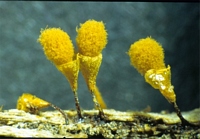|
 Hemitrichia clavata Hemitrichia clavata
SynonymsTrichia clavata
Hyporrhama clavata
BiostatusPresent in region - Indigenous. Non endemic
Images (click to enlarge)
Owner: G.L. Barron |
Article: Stephenson, S.L. (2003). Myxomycetes of New Zealand. Fungi of New Zealand. Ngā Harore o Aotearoa 3: xiv + 238 p. Hong Kong: Fungal Diversity Press.
Description: Fruiting body a stalked sporangium, gregarious to crowded, 1–2 mm tall. Sporotheca broadly clavate or pyriform, olivaceous yellow, 0.5–1.0 mm in diameter. Peridium shining, dehiscent above, one-half to two-thirds remaining as a goblet-shaped calyculus, marked within by rather coarse papillae or broken reticulations. Stalk rather short, attenuated downwards and merging gradually above into the base of the sporotheca, hollow, filled with spore-like cells, yellow above and shading into reddish brown below. Hypothallus contiguous to a group of sporangia, thin, reddish brown. Capillitium yellow or somewhat olivaceous, somewhat elastic, the threads 4.5–6.5 µm in diameter, closely wound with 4 or 5 spirals, minutely pilose, with occasional free ends, these often swollen, obtuse or tipped with a broad-based apiculus 2–4 µm long. Spores pale yellow by transmitted light, globose or subglobose, finely warted, the warts frequently forming a reticulum that is usually visible only under high magnification, 7–9 µm in diameter. Plasmodium white.
Habitat: Decaying wood
Distribution: Apparently limited largely to temperate and cool temperate regions of the Northern Hemisphere (Martin & Alexopoulos 1969, Farr 1976). First reported from New Zealand by Cheesman & Lister (1915), based on a specimen collected in Bay of Plenty.
Notes: Hemitrichia calyculata and H. clavata are sometimes difficult to distinguish, but the former is much more common. Virtually all of the collections from New Zealand that have been assigned to H. clavata in the past actually represent H. calyculata.
|